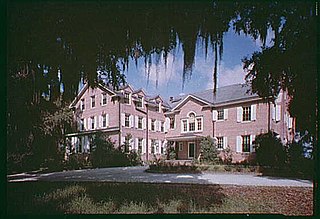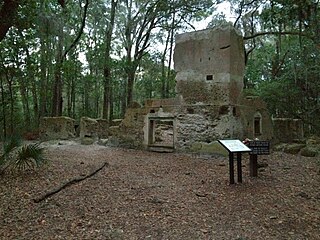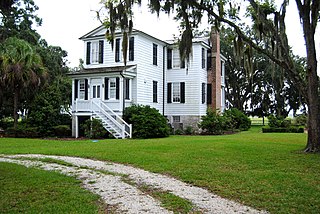
Beaufort is a city in and the county seat of Beaufort County, South Carolina, United States. Chartered in 1711, it is the second-oldest city in South Carolina, behind Charleston. Beaufort is known as the "Queen of the Carolina Sea Islands". The city's population was 13,607 at the 2020 census. It is part of the Hilton Head Island–Bluffton metropolitan area.

Auldbrass Plantation or Auldbrass is located in Beaufort County, South Carolina, near the town of Yemassee. The guest house, stable complex and kennels were designed and built by Frank Lloyd Wright from 1939 to 1941. It is one of two structures that Wright designed in South Carolina. The property was purchased in the 1930s by Charles Leigh Stevens. Wright designed the plantation to serve as a retreat for Stevens. During Stevens' retreats he would use the property for riding and hunting excursions.
Frogmore is an unincorporated community on St. Helena Island in Beaufort County, South Carolina, United States, along U.S. Route 21.

Hobcaw Barony is a 16,000-acre (65 km2) tract on a peninsula called Waccamaw Neck between the Winyah Bay and the Atlantic Ocean in Georgetown County, South Carolina. Much of Hobcaw Barony is south of US Highway 17. The land was purchased by the investor, philanthropist, presidential advisor, and South Carolina native Bernard M. Baruch between 1905 and 1907 for a winter hunting retreat. Later, his eldest child, Belle W. Baruch, began purchasing the property from her father beginning in 1936. By 1956, Belle owned Hobcaw Barony entirely. Upon her death in 1964, the property was transferred to the Belle W. Baruch Foundation for a nature and research preserve. The property includes more than 37 historic buildings and structures representative of the eras of both 18th & 19th century rice cultivation and 20th century winter retreats. Hobcaw Barony was named to the National Register of Historic Places on November 2, 1994.

All Saints Church Pawleys Island is a historic church complex and national historic district located in Pawleys Island, Georgetown County, South Carolina. The district encompasses three contributing buildings and one contributing site—the sanctuary, cemetery, rectory, and chapel. In 2004, it left the Episcopal Church to join the Diocese of the Carolinas, now part of the Anglican Church in North America, a denomination within the Anglican realignment movement.

The Camp Saxton Site is a 6-acre (24,000 m2) property located in Port Royal, South Carolina. It was listed in the National Register Historic Places on February 2, 1995.

Stoney-Baynard Plantation on Hilton Head Island, SC was listed on the National Register of Historic Places in 1994. The listing included one contributing site on 6 acres (2.4 ha).

Coffin Point Plantation, is a historic plantation house located in the Frogmore area of Beaufort County, South Carolina, USA. A Sea Island plantation.

The Frogmore Plantation Complex, located on Saint Helena Island, in Beaufort County, South Carolina, is significant for several reasons. First, the plantation home, along with its contributing properties, offers an excellent example of the area's architectural development from 1790 to 1920. Second, the plantation's long association with prominent families contributes to its significance. The plantation was first owned by Lieutenant Governor William Bull, who then willed it to his son in 1750.
The Oaks, also known as the Cooler House, is a historic plantation house located on Saint Helena Island near Frogmore, Beaufort County, South Carolina. It was built about 1855, and is a two-story, vernacular frame I-House. Edward L. Pierce chose The Oaks as his headquarters during the military occupation of St. Helena during the American Civil War. The Oaks was the center for military and agricultural activities on the island. On June 18, 1862, Ellen Murray, who had ten days earlier arrived from Pennsylvania, opened the Penn School for Freedmen in a back room of the house. The house also served as a hotel for military personnel from Port Royal, superintendents, and teachers.

Tombee Plantation is a historic plantation house located on Saint Helena Island near Frogmore, Beaufort County, South Carolina. It was built about 1790–1800, and is two-story, T-shaped frame dwelling. It is sheathed in clapboard and has a gable roof. It features a single-story front portico with four square columns and a two-story balustraded rear porch with six square columns on each floor. Along with Seaside Plantation, it is one of the few surviving antebellum plantation houses remaining on St. Helena Island. The Tombee Plantation property was divided into tracts during the days of the "Port Royal Experiment" in 1862. It remained in the hands of descendants of freed slaves until 1971.
Seaside Plantation, also known as the Edgar Fripp Plantation, is a historic plantation house located on Saint Helena Island near Beaufort, Beaufort County, South Carolina. It was built about 1795 to 1810, and is a two-story, frame dwelling in a transitional Georgian / Federal style. It features one-story hip roofed portico. Seaside was one of the plantations participating in the Port Royal Experiment and had as its labor superintendent Charles Pickard Ware (1840–1921). Charlotte Forten Grimké (1837-1914) also resided at Seaside Plantation. Along with Tombee Plantation, Seaside is one of only a few remaining antebellum plantation houses on St. Helena. Also on the property are the contributing original, brick-lined well, a clapboard shed, a large barn with clapboard siding and tin roof, and a round concrete and oyster shell silo.
Orange Grove Plantation is a historic plantation house and national historic district located on Saint Helena Island near Frogmore, Beaufort County, South Carolina. The district encompasses one contributing building and two contributing sites, and reflects the early-20th century influx of Northerners onto St. Helena Island. The plantation was first recorded in 1753 when Peter Perry purchased 473 acres. Perry owned 46 chattel slaves. The plantation house, built about 1800, was in poor condition when Henry L. Bowles (1866-1932), a U.S. Representative from Massachusetts, bought the property in 1928. He demolished it and built the present house in the same year. The property also includes the tabby ruin of the kitchen, built about 1800, and a tabby-walled cemetery containing three early-19th century graves of the Fripp and Perry families.
Parris Island Drydock and Commanding Generals House is a historic home and drydock and national historic district located at Parris Island, Beaufort County, South Carolina. The district encompasses one contributing building and two contributing structures at the Marine Corps Recruit Depot Parris Island. The drydock was constructed in the early 1890s and was one of the few wooden graving-type drydocks in the United States. It was also the largest naval drydock at the time of its construction. It fell into disrepair in the 1920s as ships began to outgrow the drydock. Quarters One, or the Commanding General's home, was constructed between 1891 and 1895, and has been the traditional home of the depot Commanding General. The two-story house has 27 rooms and features a full-width porch that also partially down both sides of the house. Associated with the home is a contributing octagonal gazebo.

Sams Plantation Complex Tabby Ruins is a historic plantation complex and archaeological site located at Frogmore, Beaufort County, South Carolina. The site, possibly built upon and occupied well before 1783. It includes the ruins and/or archaeological remains of at least 12 tabby structures. They include the main plantation house, a rectangular enclosure consisting of tabby walls, a large tabby kitchen, and five tabby slave quarters. Also on the property were a variety of tabby dependencies including a barn/stable, a smoke house or blade house, a well/dairy house, and a well. The property also includes the Sams family cemetery and Episcopal chapel enclosed by high tabby walls. Other structures include possibly an overseer's house, a granary/mill, and a tabby cotton house. During and subsequent to the American Civil War the Sams Tabby Complex was occupied by freedman. Following the Civil War the plantation house was destroyed by hurricanes.

Oakland Plantation, also known as the Wade Glover House, is a historic plantation home located near Beech Island, Aiken County, South Carolina. It was built in 1824–1826, and is a Carolina I-house with minimal mid-19th century and early-20th century additions and alterations. It has a central hall two-over-two floor plan with gable-end chimneys, one-story gallery on the facade, and shed room on the rear elevation. Also on the property are two contributing outbuildings: a frame one-story gable-end dairy house and a frame one-story gable-end garage.

Potts Plantation is a historic plantation complex and national historic district located near Cornelius, Mecklenburg County, North Carolina. The district encompasses 11 contributing buildings, 12 contributing sites, and 4 contributing structures in rural Mecklenburg County. The plantation seat was built in 1811, and consists of a two-story, three-bay, weatherboarded log house on a low brick foundation with flanking one-story wings added in 1947. The house has Federal, Late Victorian, and Colonial Revival style design elements. Associated with the plantation seat are the contributing smokehouse, dependency, poultry house, double-pen log barn work area, and corn crib. Other notable contributing resources are the Slave Cemetery, five tenant complexes, the Smith Cottage Complex, Smith Cottage, and Potts Cemetery (1946). The Potts Plantation has been the property of the Potts family since 1753.
Avirett–Stephens Plantation is a historic slave plantation complex and national historic district located near Richlands, Onslow County, North Carolina. The plantation house was built in 1851, and is a two-story, five-bay, double-pile Greek Revival style frame dwelling. It is sheathed in pine board-and-batten and sits on a brick pier foundation. It features a wide two-tiered porch with a shallow hipped roof. Other contributing resources are antebellum cistern, family cemetery, and surrounding farmland.
Mount Vernon is a historic plantation house, farm complex, and national historic district located near Woodleaf, in Scotch Irish Township, Rowan County, North Carolina. The house was built about 1822, and is a two-story, three-bay, Federal style frame dwelling. It is sheathed in weatherboard and has a full-width, one-story shed roofed porch. The house was designated a post office in 1822. Also on the property are the contributing log smokehouse, large barn, "lighthouse" or Delco house, corn crib, gear house, woodhouse, spring house, mill site, shop, and plantation office.

The Cobbler's Cottage is a ca-1870 historic cottage in the United States National Historic Landmark District – Beaufort Historic District. The Cobbler's Cottage is a contributing property of the Beaufort Historic District making the cottage a recognized member of the "National Register of Historic Places". The Cobbler's Cottage is located at Block 66, Lot C, 713 Charles Street, Beaufort, South Carolina.
















